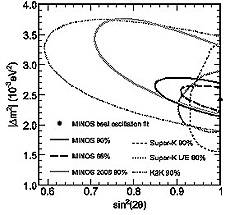Neutrino: Wave or particle?

The MINOS experiment has shown that as neutrinos oscillate from one type to another they act a lot like waves.
The MINOS experiment has shown that as neutrinos oscillate from one type to another they act a lot like waves. The experiment, which sends a beam of neutrinos from Fermilab to a detector in northern Minnesota, confirmed in 2006 the Super Kamiokande discovery that neutrinos disappear in flight. Now, MINOS confirmed that the neutrinos' disappearance arises from the wave phenomenon of oscillations.
MINOS is a large scale replay of Thomas Young's famous 1801 double slit experiment. Young was then in a debate with Isaac Newton about whether light is a wave or a particle. Particles, when added together, give us more particles. Waves, when added together, can add to each other or cancel one another out to give us nothing. (Think of noise-canceling headsets.)
Young's experiment passed light through slits in a pair of barriers (see figure on additional page). The first barrier's single slit (a) gave a source of light. The second barrier's two slits (b) created two light beams from that source. If light is a wave, those two beams when combined could either add to or cancel one another on their paths to a screen. Thus, an observer at a remote location (d) might see either bright light or no light at all. The interference pattern that Young observed seemed to confirm that light is indeed a wave.
The neutrinos in the MINOS experiment show a similar wave behavior to Young's experiment. Neutrinos produced or detected in experiments are one of three types, the electron neutrino, νe, muon neutrino, νĶ, or tau neutrino, νt. The MINOS experiment begins with a source of muon neutrinos.
A "neutrino slit experiment" occurs because these obscure particles are so massive. Since neutrinos have mass, they could also be labeled as ν 1,ν2, ν3 (light, middle, heavy). The indivdual mass states cannot be detected in nature, and any muon neutrino produced in a neutrino beam is really a superposition of all three mass types. By the time the neutrinos arrive at the MINOS detector in Minnesota they add up in different ways - like the light waves in Young's experiment - and are observed as either ν e, νĶ, or νt. Because the MINOS detector sees only muon neutrinos, those neutrinos that combine as either electron or tau neutrinos appear to be lost, resulting in a deficit of muon neutrinos.
Read more
|